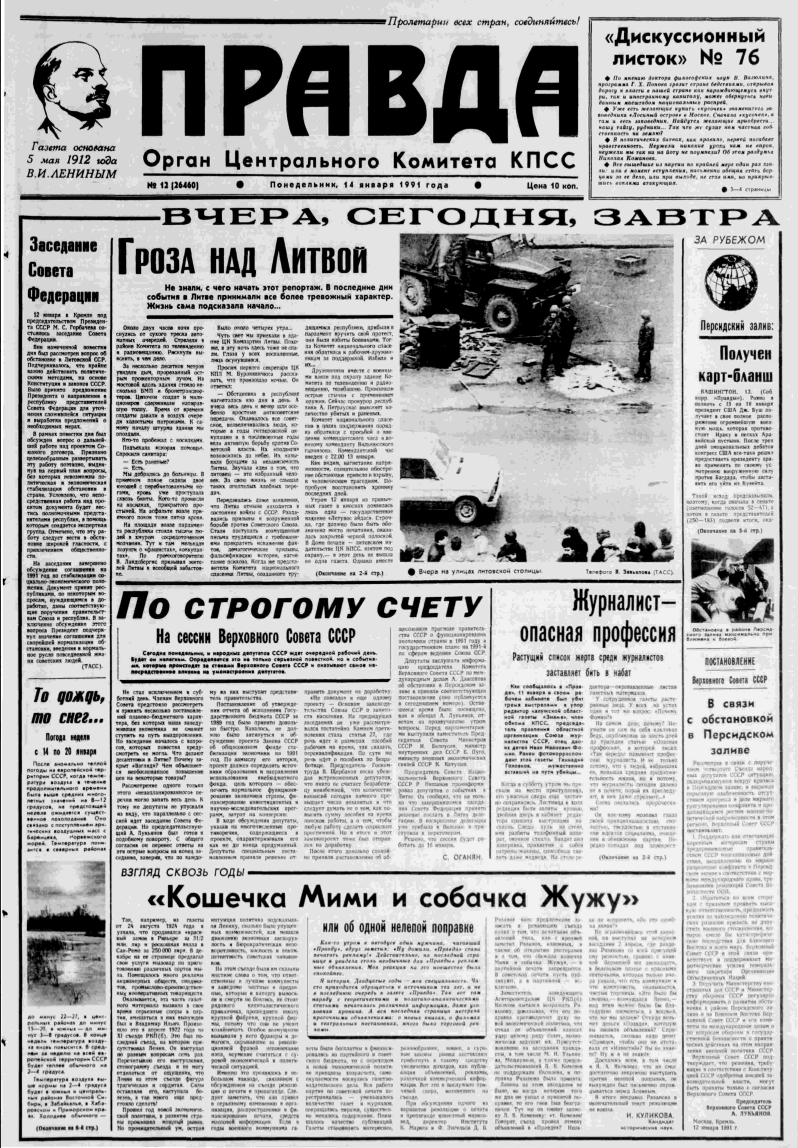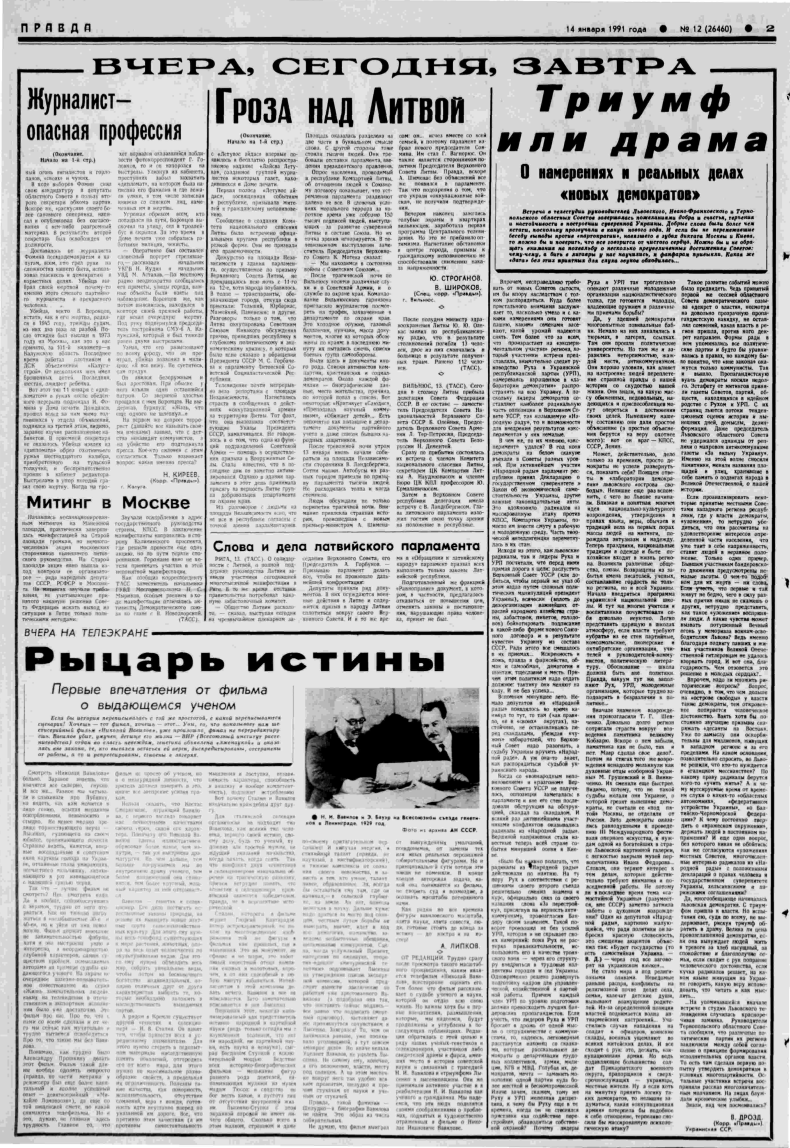Tanks in Lithuania
[2 items]
STORM OVER LITHUANIA
We didn't know how to start this report. In recent days, events in Lithuania have taken an increasingly alarming turn. Life itself suggested the beginning...
Around two in the morning, we woke up to the dry crackle of automatic gunfire. The shooting was coming from the area of the Committee for Television and Radio Broadcasting. We risked finding out what was happening.
Several dozen meters away, we saw smoke cut through by a sharp spotlight beam. Several infantry fighting vehicles and armored personnel carriers were stationed along the street by the building. Chains of soldiers and police officers were holding back the pressing crowd. From time to time, soldiers fired bursts of blank cartridges into the air. We missed the very beginning of the building's storming.
Someone ran by with a stretcher.
An ambulance arrived. We asked the paramedic: "Are there any wounded?" "Yes."
We made it to the hospital. In the emergency room sat two young men with bandaged legs, blood already seeping through the bandages. Someone was carried by on a stretcher, covered with a sheet. There were also bloodstains on the asphalt near the emergency room.
In the square by the republic's parliament stood thousands of people in grim, concentrated silence. Here and there, slogans about "fascists" and "occupiers" could be seen. Over the loudspeaker, V. Landsbergis called on the residents of Lithuania for a general strike.
It was around four in the morning...
Shortly after dawn, we arrived at the building of the Central Committee of the Lithuanian Communist Party. It seemed no one had slept here either that night. Everyone's eyes were inflamed, their faces haggard.
We ask the First Secretary of the CC LCP M. Burokevičius to tell us what happened during the night. He replied:
"The situation in the republic has been escalating day by day. And yesterday, all day and evening, particularly fierce anti-Soviet broadcasts were aired. Everything Soviet was denigrated, while people who actively fought against Soviet power during the years of Hitler's occupation and in the post-war years were glorified. Their 'feats' were elevated to the heavens. They were called fighters for Lithuanian independence. The idea that Lithuanians are chosen people was promoted. In my life, I have never heard such rabid, malicious broadcasts."
Statements were even transmitted that Lithuania is now in a state of war with the USSR. There were calls for armed struggle against the Soviet Union. Indignant letters began arriving from workers demanding an end to the distortion of facts, demagogic appeals, falsification of history, and incitement of hysteria. When representatives of the National Salvation Committee of Lithuania, created by the republic's workers, arrived at parliament to deliver their protest, they were beaten by militants. Then the National Salvation Committee appealed to worker volunteers for support. They too were beaten...
The volunteers, together with the military, took the building of the Committee for Television and Radio Broadcasting and the TV tower under protection. Sharp clashes occurred with the use of weapons. Now the republic's prosecutor A. Petrauskas is determining the number of dead and wounded.
The National Salvation Committee, in order to maintain order, appealed to the military commandant of the Vilnius garrison with a request to impose a curfew. A curfew was introduced from 10:00 PM on January 13.
As we can see, the escalation of tension and deliberate aggravation of the situation led to an explosion, to human tragedies. Let's try to reconstruct the chronicle of recent days.
On the morning of January 12, of the usual newspapers, only one appeared in the kiosks—the state publication "Lietuvos Aidas." The line where the printing location should have been indicated was covered with a black strip. In the House of the Press—the Lithuanian publishing house of the CPSU Central Committee, which was taken under protection—not a single newspaper was published that day. However, along with "Lietuvos Aidas," a free publication "Laisva Lietuva," created by a group of journalists from some newspapers previously housed in the House of the Press, appeared for the first time.
The front page of "Lietuvos Aidas," dedicated to events in the republic, called on residents for civil disobedience.
The announcement about the creation of the National Salvation Committee of Lithuania was met with sharp rejection by the republic's official circles. They did not recognize its legitimacy.
The vigil in Independence Square at the parliament building, carried out at the call of the Supreme Council of Lithuania, continued throughout the night from the 11th to the 12th, although the crowd had thinned. In the crowd were banners indicating the cities from which people had come: Telšiai, Jurbarkas, Mažeikiai, Panevėžys, and others. Conversations were only about Lithuania being occupied by the Soviet Union. There was no discussion of the causes that led the republic into a deep political and economic crisis, which were clearly stated in the address of USSR President M. S. Gorbachev to the parliament of the Lithuanian Soviet Socialist Republic.
Television almost continuously broadcast reports from Independence Square. Passions were inflamed in reports about the actions of the "occupation army" on Lithuanian territory. The fact that it was fulfilling the relevant Decrees of the President of the USSR was concealed. Nor was it mentioned that one of the functions of Soviet Army units is to assist in implementing the draft into the Armed Forces. It became known that in recent days this had noticeably intensified. However, on this day in the parliament building, a group of volunteers from the Department for the Protection of the Region took an oath of allegiance to Lithuania.
From conversations with people in Independence Square, it is clear that not everyone in the republic agrees with the parliamentarians' point of view. The square was literally divided into two parts. On the other side stood thousands of people too. They demanded the resignation of parliament and the introduction of presidential rule.
A poll conducted in the republic by the Communist Party of Lithuania regarding people's attitude toward the Union Treaty shows that the parliament's aspirations are not shared by all. Under difficult conditions of moral terror, in a short time 150,000 signatures have already been collected from people advocating for the development of a sovereign Lithuania within the Union. But their point of view is ignored. In a television address, Deputy Chairman of the Supreme Council K. Moteka said:
"We are in a state of war with the Soviet Union..."
After the tragic night, various rumors about both the Soviet Army and the regional protection service are circulating around Vilnius. The command of the Vilnius garrison invited journalists to look at trophies seized from the Department for the Protection of the Region. These included cold weapons, a gas canister, nunchucks, a mass of documents (many of which were burned at the edges—they tried to burn them at the last minute), and lists of combat self-defense groups.
There were also documents of a different kind. Lists of activists from the Communist Party, Christian Democrats, and Social Democrats. Next to each surname were biographical data, place of residence, and the reason for being included in the list. Here are some: "Criticizes 'Sąjūdis'?", "Taught scientific communism", "Mistreats children"... There were also party registration documents that somehow ended up in the department and even a list of former people's defenders.
After the alarming night, on the morning of January 13, supporters of V. Landsbergis again began to gather in Independence Square. Hundreds of cars. Buses from different cities brought thousands of people at the parliament's call. The crowd did not disperse even when it got dark.
People discussed not only the events of the tragic night. Attention was drawn to a strange incident involving the new Prime Minister A. Šimėnas: he... disappeared along with his family, and therefore the parliament elected a new Chairman of the Council of Ministers. G. Vagnorius, who is also a supporter of the policy of the Chairman of the Supreme Council of Lithuania, took this position. However, A. Šimėnas soon appeared in parliament without explanation. So suspicions that he was kidnapped by "occupation troops" were not confirmed.
In the evening, the blue screens in Vilnius residents' apartments finally lit up: the first program of Central Television began working. But this did not add optimism. The escalation of the situation in the city center and calls for civil disobedience did not help reduce the intensity of tension.
Y. STROGANOV. V. SHIROKOV. (Special correspondents of "Pravda"). Vilnius
After noon, Lithuanian Minister of Health Y. Y. Olekas announced on republican radio that as a result of the clashes, 13 people died, two of them died in the hospital as a result of injuries received. 112 people were wounded. (TASS).
VILNIUS, 13. (TASS). Today a delegation of the USSR Federation Council arrived in the capital of Lithuania. It includes Deputy Chairman of the Council of Nationalities of the USSR Supreme Soviet B. Oleinik, Chairman of the Supreme Soviet of Armenia L. Ter-Petrosyan, and Chairman of the Supreme Soviet of Belarus N. Dementey.
Immediately upon arrival, they met with a member of the National Salvation Committee of Lithuania, Secretary of the CC of the Lithuanian Communist Party A. Naudžiūnas and member of the Bureau of the CC LCP Professor Y. Yermalavičius.
Then in the republic's Supreme Council, the delegation had a meeting with V. Landsbergis. The head of the Lithuanian parliament presented his point of view on the situation in the republic to the guests.
The tragic events of 11-13 January 1991 in Lithuania built on over a year of tense relations between the republic and the central government in Moscow. Following the Human Chain on 23 August 1989 and Estonia’s declaration of Independence in March 1990, the Lithuanian government declared its own independence from the Soviet Union on 11 March 1990. Thereafter it worked toward economic self-sufficiency, which the Soviet central government sought to block by sending troops to occupy several state buildings and imposing an economic blockade between April and late June 1990. Violence erupted in the capital of Vilnius on 11 January 1991 and lasted through Sunday, 13 January 1991, now known as Bloody Sunday. According to the BBC, 14 people were killed and over 140 injured by Soviet troops.
The coverage of these events in Pravda, the Russian Communist Party’s press organ since 1911, was remarkable. Not only was it deeply sympathetic to the Lithuanian cause, but the article “Storm over Lithuania” appeared promptly on 14 January, even as those most affected by the tragic, violent events were still trying to determine what had happened. The article did no favors to the Soviet central government. In marked contrast with its coverage of Soviet troops’ violent suppression of protests in Tbilisi, Georgia in April 1989, Pravda offered no support to the Soviet central government and in no way tried to justify violent intervention, although it did point out that “not everyone in the republic agrees with the parliamentarians’ point of view.” This response no doubt helped reverse the course of the Soviet central government in terms of its handling of Baltic states’ declarations of independence. Although Soviet troops remained in Lithuania for a time following 13 January 1989, there was no more intense violence. On 11 March 1991, the Lithuanian government had signed the “Act of the Re-Establishment of the State of Lithuania,” with full, internationally recognized independence from the USSR to follow in the coming months.

